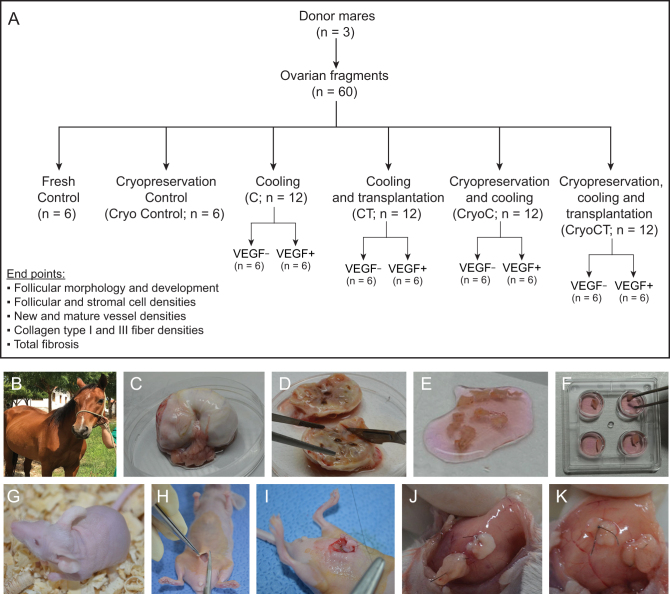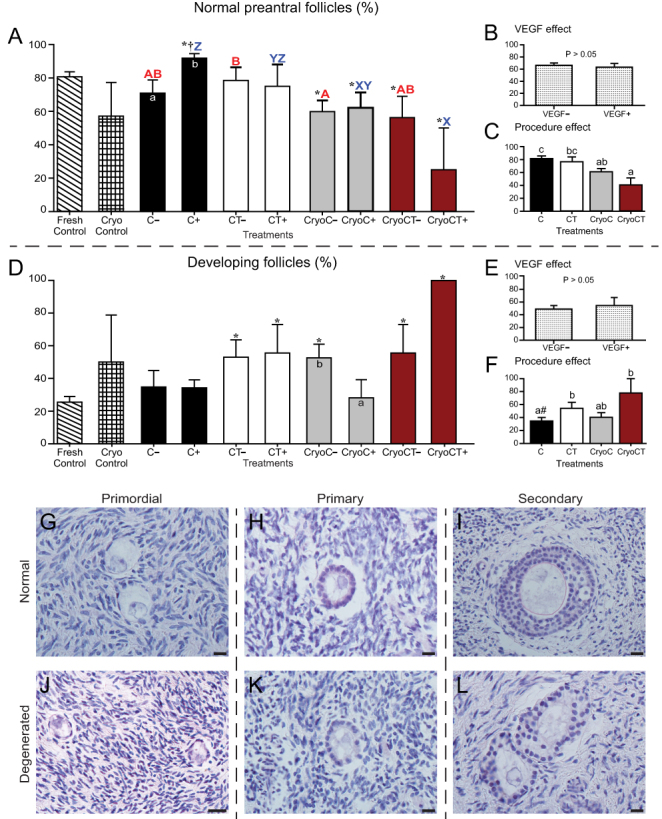Equine ovarian tissue xenografting: impacts of cooling, vitrification, and VEGF.
引用次数: 1
Abstract
Ovarian tissue transplantation methods using cooled and cryopreserved samples have been attractive options for fertility preservation in animal models and humans. The aim of this study was to evaluate the impact of previous exposure to cooling, cryopreservation, and VEGF on the overall efficiency of equine ovarian tissue after heterotopic xenotransplantation in mice. The end points evaluated were follicular morphology and development, follicular and stromal cell densities, angiogenesis (i.e. the density of new and mature blood vessels), collagen types I and III fiber densities, and total fibrosis. Ovaries of adult mares were harvested after ovariectomy, and ovarian fragments were xenografted in the i.p. wall of BALB nude mice. Ten types of treatments involving different combinations of cooling, cryopreservation, xenografting procedures, and VEGF exposure were compared. The novel aspect of this study was the use of equine ovarian tissue xenotransplantation in mice, challenging the fragments with different combinations of treatments. The main findings were (i) cooling but not cryopreservation was effective in preserving the follicular morphology, (ii) a greater percentage of developing follicles but lower follicular and stromal cell densities were observed after ovarian tissue engraftment, (iii) exposure to VEGF increased new and mature vessels in cryopreserved-transplanted tissue, and (iv) an appropriate balance in the collagen types I and III fiber ratio in cooling-transplanted tissue was observed after exposure to VEGF. This study contributes to advancing knowledge in the preservation of ovarian tissue after cooling-cryopreservation and transplantation aiming to be applied to genetically superior/valuable horses, livestock, endangered animals, and, possibly, humans. Lay summary Due to ethical limitations involving humans, the female horse (mare) has recently emerged as an alternative model for reproductive comparisons with women to optimize fertility restoration using ovarian tissue transplantation techniques. This study determined if ovarian tissue from donor mares (n = 3), exposed or not to vascular endothelial growth factor (VEGF) before transplantation, better survives for 7 days after transplantation into mouse hosts (n = 12). Tissues submitted to different combinations of cooling, freezing, and transplanting treatments, along with control groups, were evaluated using the parameters morphology, development, the density of immature eggs (follicles), the density of supportive (stromal) cells, collagen protein proportions, and density of blood vessels. Frozen-thawed treatments had lower percentages of normal follicles. Exposure to VEGF increased blood vessel densities in frozen tissue and favored adequate collagen levels in cooled-transplanted treatments. In conclusion, VEGF exposure seems to be beneficial for mare ovarian tissue transplantation and warrants further investigation.



马卵巢组织异种移植:冷却、玻璃化和VEGF的影响。
在动物模型和人类中,使用冷却和冷冻保存样本的卵巢组织移植方法是保存生育能力的有吸引力的选择。本研究的目的是评估先前暴露于冷却,冷冻保存和VEGF对小鼠异位异种移植后马卵巢组织整体效率的影响。评估的终点是卵泡形态和发育、卵泡和基质细胞密度、血管生成(即新血管和成熟血管的密度)、I型和III型胶原纤维密度以及总纤维化。取成年母马卵巢切除后,将卵巢碎片异种移植于BALB裸鼠的上壁。比较了10种不同的治疗方法,包括冷却、冷冻保存、异种移植和VEGF暴露的不同组合。这项研究的新颖之处在于将马卵巢组织异种移植用于小鼠,用不同的治疗组合挑战这些片段。主要发现是(i)冷却而非冷冻保存在保存卵泡形态方面有效,(ii)卵巢组织植入后观察到更多的卵泡发育百分比,但更低的卵泡和基质细胞密度,(iii)暴露于VEGF增加了冷冻保存移植组织中的新血管和成熟血管,(iv)暴露于VEGF后观察到冷却移植组织中i型和iii型胶原纤维比例的适当平衡。本研究有助于提高冷冻保存和移植后卵巢组织的保存知识,旨在应用于遗传优越/有价值的马、牲畜、濒危动物,甚至可能应用于人类。摘要:由于涉及人类的伦理限制,雌性马(母马)最近成为与女性生殖比较的替代模型,以优化使用卵巢组织移植技术恢复生育能力。本研究确定了供体母马(n = 3)的卵巢组织在移植前是否暴露于血管内皮生长因子(VEGF),移植到小鼠宿主(n = 12)后7天的存活率更好。组织接受不同的冷却、冷冻和移植组合处理,并与对照组一起,使用形态学、发育、未成熟卵(卵泡)密度、支持(基质)细胞密度、胶原蛋白比例和血管密度等参数进行评估。冻融处理的正常卵泡百分比较低。暴露于VEGF增加了冷冻组织中的血管密度,并有利于在冷却移植治疗中达到足够的胶原水平。总之,VEGF暴露似乎对母马卵巢组织移植有益,值得进一步研究。
本文章由计算机程序翻译,如有差异,请以英文原文为准。
求助全文
约1分钟内获得全文
求助全文

 求助内容:
求助内容: 应助结果提醒方式:
应助结果提醒方式:


